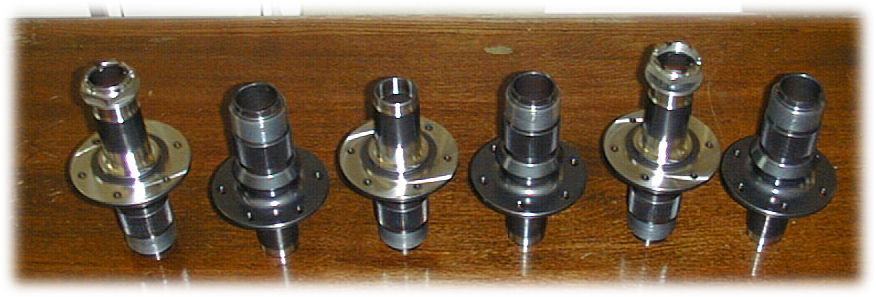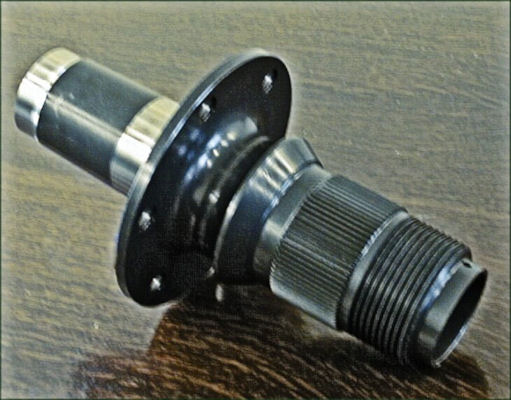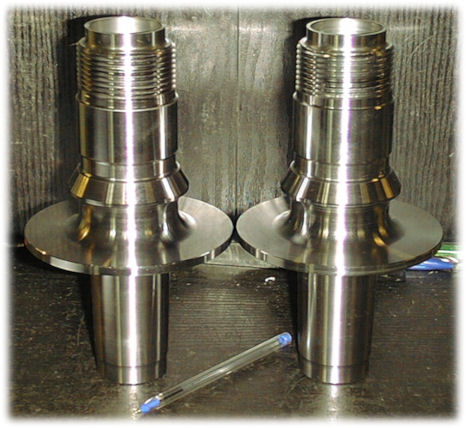
This trim die is typical of thousands made by C.W.Walker between 1918 and 1990. The very first customer was the Auto Machinery Company Ltd in Aldermoor Lane which had been set up by Hillman to make bolts his car factory. After 1960 we also supplied Unbrako Limited who manufactured bolts and set screws by the million.
The dies were made from High Speed Steel which contains a lot of both nickel and tungsten. This latter was in very short supply during the Korean War in 1948 as North Korea was one of the main sources of the material. The price of High Speed Steel went through the roof. By good fortune we were given free issue material by one customer and the swarf - waste material - was worth more than the product. That was a very profitable time for the company.
That particular product kept the business afloat for at least thirty years.
A Shackle Pin for the Standard Motor Company armoured car
During and after world war two the company made thousands of these pins. The pin was heat treated to strengthen and harden it in our own furnaces and all operations were completed in house. This last remaining sample has not been ground and the turning marks can be seen on the diameter which is around .25mm above a the nominal size of 7/16 ths of and inch.
A typical car steering shaft
between 1980 and 2000 the company produce many hundreds of these shafts for various low-volume car manufacturers. The shaft has a standard SAE serration for steering joints.
This shows lugs being milled on a brake lever for a Newage dumper truck around 1985. Shortly after this photo was taken production was transferred to a new Computer Numerically Controlled machine. Such machines have since transformed much of British Industry and are similar in some respects to robots. They have displaced thousand of machine operators.
Microphone Cover
We made several hundred of these covers around 1990. They covered a microphone designed to be work on the wrist and used for reporting meter readings to a computer by voice.
Brake Shoes
This is a pair of brake shoes made for the restoration of a Lagonda motor car. The company produced many such items of many descriptions for the restoration of vintage cars.
Formula 1 Stub axles
Rear Axle
Other that the prop shaft (left) and the casting, all of this axle was designed
and made in house around 2000.




The four photos above show a variety of stub axles for F1 cars in a variety of stages of manufacture. Most of these were made of Maraging Steel. This is a very high tensile steel which can be heat treated after machining to a very high tensile strength with very little distortion. These axles typically cost £200 to manufacture but the material blank to make each one cost about £800. one day this customer walked in with ten blanks and asked us to start work on them immediately. By the end of the day we had drilled holes through the middle and faced the ends to the required size. The next morning he phoned to say he had changed the design but it was too late to salvage the material. That little lot cost him around £10,000 in scrap material.
This special material is produced by only one company in California and is jealously guarded by the US military because it is the only material that can be used to make the centrifuges necessary to produce fissionable material for atom bombs. I have seen it used on the foils for the Canadian Bras D'or submarine destroying hydrofoil that I worked on in 1966 and for these F1 axles and we tried it for the Jaguar B220 drive shafts but it was not suitable.
A chinese delegation allegedly recently tried to buy some claiming it was for making the swings in a children's playground. Nice try - but a little unconvincing. It is at least 20 times more expensive than ordinary mild steel.
Telephone Alarm Dialer
Around 1990 we diversified into the manufacture of various electronic devices. This was designed by an associate and developed within the company. It was the very first solid state (electronic chip) driven dialler certified for connection to the British Telecom network. it was certified by BT at Dollis Hill, the certification soon afterwards being devolved to the Ministry of the Environment. The device was technically good but the sales and promotion costs proved unrealistic and the project was sold.
These products are just a few of the thousands manufactured between 1918 and 2005 and show the wide range of tasks and skills required.
Colin Walker 2012